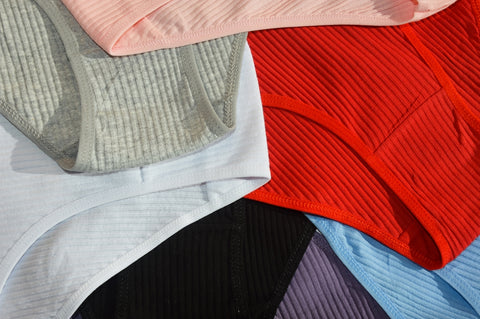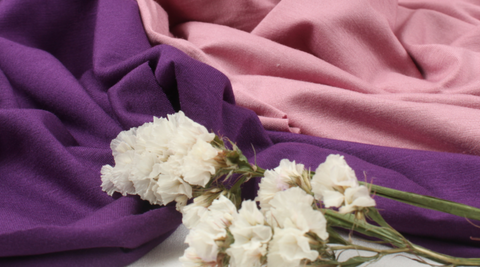
Fabrics for Sustainable Underwear and Lingerie: A Guide for Fashion Designers
From design to production, one crucial area where we can make a significant impact is the choice of fabrics for underwear and lingerie. By selecting sustainable materials, we not only contribute to a healthier planet but also provide our customers with high-quality, eco-friendly products that align with their values. In this article, we will explore some of the finest sustainable fabrics available for underwear and lingerie, highlighting their benefits and providing product examples.

Characteristics of Underwear Fabrics
When selecting fabrics for underwear, it is essential to consider specific characteristics that contribute to comfort, hygiene, and overall satisfaction for the wearer. Here are some key qualities to look for in fabrics used for underwear:
-
Softness: Underwear fabrics should be gentle and soft against the skin to ensure maximum comfort throughout the day.
-
Breathability: Breathable fabrics allow air circulation, preventing moisture buildup and promoting freshness. This characteristic is particularly important for intimate wear, as it helps maintain hygiene.
-
Moisture-Wicking: Fabrics with moisture-wicking properties draw sweat away from the body, keeping the skin dry and reducing the risk of irritation or discomfort.
-
Stretch and Flexibility: Underwear fabrics should offer adequate stretch and flexibility to provide a comfortable fit that moves with the body without constricting or causing discomfort.
-
Durability: Since underwear is worn frequently and subject to washing, it is crucial to choose fabrics that are durable and can withstand regular use without losing their shape or integrity.
-
Hypoallergenic: Allergies and sensitivities are common concerns when it comes to intimate wear. Opting for hypoallergenic fabrics can help minimize the risk of skin irritations or allergic reactions.
-
Odor Resistance: Fabrics with odor-resistant properties can help keep the underwear fresh and reduce the need for frequent washing, contributing to both sustainability and convenience.
-
Easy Care: Fabrics that are easy to care for, quick to dry, and require minimal ironing are preferable for everyday underwear.

A Brief History of Underwear
Underwear, or lingerie, has a fascinating history that has evolved over centuries to meet changing societal norms and fashion trends. Let's take a glimpse into this journey:
Ancient Times
In ancient civilizations such as Egypt, Greece, and Rome, loincloths and undergarments made from linen or wool were worn for practical and modesty purposes.
Medieval and Renaissance Era
During the Middle Ages, undergarments became more structured, with women wearing corsets to achieve a desired silhouette. Men and women also started using drawers or breeches, typically made from linen or wool.
18th and 19th Centuries
The industrial revolution brought advancements in textile production, leading to the use of cotton and the development of sewing machines. Undergarments like chemises, petticoats, corsets, and drawers became more common and refined.
20th Century
The early 1900s saw a shift towards lighter, more comfortable undergarments. The invention of elastic and synthetic fibers introduced new possibilities for underwear design. Corsets gave way to brassieres and girdles, and briefs and boxers were introduced for men.
Contemporary Era
In recent decades, there has been a focus on comfort, functionality, and inclusivity in underwear design. Natural and sustainable fabrics, as well as body-positive messaging, have gained prominence. With advancements in technology, seamless and moisture-wicking fabrics have become popular choices.
Today, underwear serves not only as a functional garment but also as a means of self-expression, empowerment, and embracing individuality. Designers and brand owners now have the opportunity to integrate sustainable fabrics into their collections, providing consumers with ethically made and comfortable intimate wear that aligns with their values.

Best Materials for Underwear and Lingerie
-
Organic Cotton: Organic cotton is a popular choice for eco-conscious fashion brands due to its numerous advantages. Grown without the use of harmful pesticides and synthetic fertilizers, organic cotton reduces environmental impact and promotes better working conditions for farmers. This fabric is naturally soft, breathable, and gentle on the skin, making it perfect for intimate wear.
-
Bamboo Fiber: Bamboo fiber is a versatile and sustainable option that has gained popularity in recent years. It is derived from the fast-growing bamboo plant, which requires minimal water and does not need pesticides. Bamboo fabric offers exceptional breathability, moisture-wicking properties, and a luxurious feel.
-
TENCEL™ Modal: TENCEL™ Modal is a regenerated cellulose fiber made from sustainably sourced beech wood. The production process involves minimal chemical inputs and utilizes a closed-loop system, ensuring water and resource conservation. This fabric boasts incredible softness, breathability, and enhanced moisture absorption, making it ideal for delicate lingerie pieces.
-
Recycled Nylon and Polyester: To combat the environmental impact of synthetic fibers, recycled nylon and polyester offer sustainable alternatives. These fabrics are made from post-consumer waste, such as discarded fishing nets and plastic bottles, which reduces landfill waste and promotes circularity. Reformation's recycled nylon and polyester lingerie range beautifully demonstrates how recycled materials can be transformed into stylish and environmentally conscious undergarments.

By exploring innovative fabric options like these, we can pave the way for a more sustainable and ethical future in intimate wear. Let us prioritize sustainability and create fashion that respects both people and the planet.
Fabricsight.com can be used as a reference to explore a wide range of sustainable fabrics, providing designers and brand owners with valuable insights and options for their collections.
